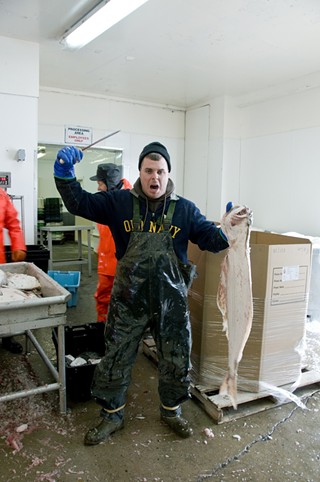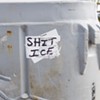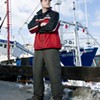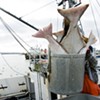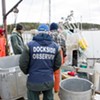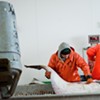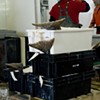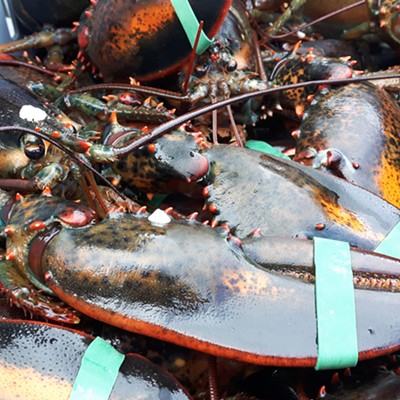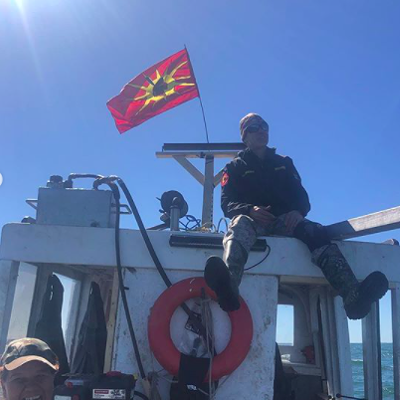We've got a strange relationship with fish.
On the one hand, Nova Scotia pretty much is fish. The human geography of the province consists mainly of hundreds of settlements built around the coves and inlets that stretch along our coasts. From the Mi'kmaq forward, fishing has been the foundation of the local economy and fishing continues to be one of our primary industries. Moreover, those picturesque fishing villages are also the main lure of the tourist trade---another primary industry.
Our cultural geography is, likewise, constructed around fishing and the sea; from the ballads and songs about Nova Scotia to the decor of the student bars downtown, fishing serves as a cultural self-identifier.
On the other hand, who here in the city really knows anything about fish? There's not even a daily fishmonger on the peninsula: a place to buy fresh fish on the way home from our office jobs. Sure, there are any number of seafood restaurants in town in which we can indulge our seafaring-roots fantasy, but the fish served in local restaurants often has no connection whatsoever with the villages and industry we embrace as our own.
Welcome to the global fish economy. There's always been an international trade in fish---the fishing villages on our coast existed in the first place thanks to exports of salted cod to Europe---but the hyper-global trade that defines modern fishing began in 1972, when a Japanese businessman figured out how to navigate the technological and administrative roadblocks standing in the way of shipping tuna caught off Prince Edward Island to Japan. Thus began the global sushi craze and, following that, the realization that anyone who could afford it could eat fish caught anywhere.
So now a diner at Picasso's, a mid-range seafood restaurant in Winnipeg, can order grouper flown in fresh from Portugal and the Five Fishermen restaurant in Halifax, just blocks away from the edge of the Scotian Shelf, once one of the most productive fisheries on Earth, serves Chilean sea bass.
The marvels of the international seafood industry are explained by the proprietor of a local sushi house: "Japanese fish companies purchase 3,000 tonnes of mackerel from the shores of the Atlantic provinces every year, ship it to Tokyo, where it is cured in brine and seaweed from three to six months, packaged as shime saba and shipped back to Vancouver, where I purchase it from a supplier and serve approximately 300 pounds of it a year. It is a delicacy of sorts, unable to be reproduced anywhere in the world."
Cockroaches of the sea
Truly, from the consumer's perspective, the globalized seafood industry has taken dining to new heights. But it's the worst thing that could have happened to the fisheries.
In a 2003 paper published in the scientific journal Nature, Dalhousie University marine biologists Ransom Myers and Boris Worm found that since the beginning of industrialized fishing in the 1950s, 90 percent of the world's large fish had disappeared. "[W]e have only 10 percent of all large fish---both open-ocean species including tuna, swordfish, marlin and the large groundfish such as cod, halibut, skates and flounder---left in the sea," wrote Myers in a press release.
That process had been so accelerated by the $80 billion (US) globalized annual seafood trade that Worm warned in a 2006 paper published in Science that if present trends continue there will be no fish at all within 40 years. "It's within our lifetime," Worm told the Washington Post. "Our children will see a world without seafood if we don't change things."
Those warnings were met with skepticism by much of the world, but Atlantic Canadians paused when they heard the prediction, because in the early 1990s our region experienced a textbook example of fishery collapse.
The state of the Nova Scotia fishing industry is the subject of Fisheries and the Marine Environment in Nova Scotia, a report issued last month by Halifax think-tank GPI Atlantic.
The report notes that by all conventional measures---the size of the annual catch, the value of fish exports and the fisheries' contribution to the province's gross domestic product---the ground fisheries (cod, pollock and haddock) off Nova Scotia were in excellent shape, growing every year from the 1970s through the 1990s.
Through the 1980s, warnings from marine biologists that groundfish were being over-fished were ridiculed and ignored. Regulators pointed at the high-catch numbers and big money being brought in by fish exports as proof that there was nothing to worry about.
Those numbers, however, didn't measure the underlying health of the ecosystem. "Over that time period, 'behind the scenes,' fish stocks were dropping, and by 1992-1993, many fisheries were collapsing, and the fabric of coastal communities began to unravel," wrote lead author Anthony Charles.
Just like that, practically overnight, the groundfish disappeared.
GPI argues convincingly that different measures should be used to value the fisheries, including consideration for the health of fishing communities and the number of young people pursuing careers in fishing, among others. On the purely monetary side of the equation, GPI seeks a fuller accounting; one measure used in the report is the value of the natural capital of the fish in the sea---that is, the dollars that would be brought in if every last fish was plucked out of the ocean and sold at market rates.
Looking at it from that point of view, the collapse is especially dramatic. The report explains: "The value of natural capital for cod in the Eastern Scotian Shelf region off Nova Scotia increased through the 1980s to a peak of $200 million in 1987, but then exhibited a steady decline in value from 1987 to 2002, as the collapse of the cod stock led to historically low levels of natural capital in 2002 (the most recent year in our data). By 2002, virtually the entire $200-million value that had been present in the Eastern Scotian Shelf cod stock had been wiped out---what was left amounted to only an estimated $9 million in 2002."
On the Scotian Shelf, 16 years after the collapse, there is still no evidence of a recovery for the cod fishery. It may be gone forever. Haddock and pollock are still depressed, but their numbers are increasing slightly.
Even in conventional GDP terms, the fishery isn't healthy. In the three years after the groundfish collapse, the GDP for the fishing industry was cut nearly in half. Since then, the fishery has increased in value somewhat, but it's still at only 80 percent of the 1992 level.
And that increase comes mostly from one species: lobster. With no groundfish to catch, the industry, and especially the South Shore fishing communities, focused increasingly on lobster.
There's nothing wrong with catching lobster---it gives people an income and it brings a lot of money into Nova Scotia. That's good.
But the GPI report underscores two problems with an over-reliance on lobster. First, although trapping lobster seems not to adversely affect the environment (in the way, say, bottom trawling does), we don't really know if it's possible to over-catch them.
We don't have the kind of biomass numbers for lobster out in the sea that GPI used for finding the natural capital of groundfish, so we're left with making guesses based on how many pounds of lobster are hauled in and sold. Those numbers increased through the 1980s, but then remained stable through 2001, suggesting the lobster fishery was in good health. But since then, the numbers increased dramatically, to 20,000 tonnes---about five times what was being caught in the 1970s.
Then, in 2007, the take of lobster plunged 30 percent from 2006 levels. Was this the beginning of a general collapse of the lobster fishery, just as the groundfish had collapsed in the 1990s? Such a thing has never happened with lobsters. It's hard to say what it means for the future.
The second problem with the over-reliance on lobster, says GPI, is that if, for whatever reason, the market goes south, there goes the value of the entire industry and the thousands of jobs that depend on it.
And sure enough, in November of last year the global financial collapse hit home. Americans suddenly found lobster an unnecessary luxury. Nova Scotian processors couldn't sell much lobster and so the price paid to those catching lobster collapsed; in a desperate attempt to make ends meet, lobstermen and women began hawking their catch to locals from the back of pickup trucks around the province.
The price of lobster recently recovered somewhat. Still, the episode underscores the precarious nature of a one-species industry.
Both GPI and Susanna Fuller, a marine biologist and marine conservation co-ordinator at the Ecology Action Centre, make the further point that the lobster economy relies on the lowest trophic level of the sea---the bottom of the food chain.
"We've got a fishery dominated by invertebrates," says Fuller. "It's like we only eat cockroaches instead of cows. There's nowhere else to go, unless we start eating jellyfish like the Japanese have."
Better fish
With fisheries collapsing and the industrialized global food network making things worse, a conscientious eater might be inclined to eat less fish, or none at all, for the sake of the planet. Opting out, however, doesn't much affect the fish economy.
It may seem counterintuitive, but activists and many working in the fisheries say the best way to help the fish environment, and to help local fishing communities, is to eat more fish, not less. That is, so long as we insist on high-quality, locally caught and environmentally sustainable fish.
Of late, many consumers have come to value local agriculture, as books like The 100 Mile Diet become bestsellers and local farmers' markets have record sales. It's time, says Fuller, to bring that local food consciousness to seafood. "We're five or 10 years behind the terrestrial food market," she explains. "All the chefs in town, they know who produces their pork, they know who they get their potatoes from:the higher-end chefs, they have a personal connection to their supplier. But they have no idea who catches their fish---it comes in a truck, with a driver, who's not responsible for the fish. So that connection to the people who are fishing, and respecting fish as food, I don't know that we have it here."
Like its local land-food counterpart, those advocating for local seafood envision a thriving small-market economy, with lots and lots of people working on the water to catch relatively few fish each. In order for them to make a living, the price of sustainably caught fish will have to be higher than the fish caught by gigantic trawlers pumping product into the international fish economy, just as the price of sustainably raised local beef is higher than industrialized beef shipped in from South America.
There are, says Fuller, three local fisheries that especially need our support.
First is the trap-caught shrimp of Chedabucto Bay, outside Canso, a small town that has been struggling since the ground fisheries collapsed. Trapping shrimp does little or no damage to the environment, but until recently, there has been no way for consumers to ask for these shrimp directly---they were simply dumped into the larger shrimp economy, undistinguished from any other shrimp caught on the planet.
Recently, however, the Ecology Action Centre has been pushing to get the Chedabucto shrimp separately labelled and to convince local consumers to put a premium value on them---that is, to pay more money, just as they'd pay more for local organic apples. In season, the shrimp are available at Fisherman's Market on the Bedford Highway and through Local Source Market in the north end.
Fuller's second example is Digby clams. Like the trap-caught shrimp, clams can be a sustainably caught species that doesn't harm the environment, but the clam diggers in and around Digby are having a rough time of it due to repeated beach closures related to raw sewage discharges from the town's sewage plant. Clammers are joining with environmentalists to push for a solution to the sewage issue, but they don't seem to get much traction with government officials, who perhaps see them as inconsequential.
Ken Weir, president of the of the Annapolis Basin Clam Harvesters' Association, says his group favours a strict quota system combined with a beach clean-up and repair of the sewer system. But like lobsters, the clam market took a hit with the global financial collapse. "We're too dependent on the American markets," he says. "We should be shipping within Canada and not worrying about these other markets."
As Fuller and Weir see it, local awareness and consumption of Digby clams raises the political profile of the fishery, which in turn will put pressure on government to resolve the sewage and beach-closure issues, giving yet more value to the fishery and supporting the communities that depend on it.
Many local restaurants offer and advertise Digby clams, but some that serve them seem unaware of the potential added value they can claim in consumers' eyes. "We have to work on local branding," says Fuller. "Probably nobody even knows the clams at Gus' Pub are Digby clams."
Fuller's third example is harpoon-caught swordfish. Remarkably, Nova Scotia's South Shore is the only place in the world where there are still people---33 of them, exactly---who harpoon for swordfish. Because there is no bycatch---other fish caught up in lines or nets---this is another environmentally sustainably way of fishing and, like Fuller's other examples, it is labour-intensive, relative to the longline boats that ply farther out to sea. But harpoon-caught swordfish are not differentiated from the line-caught swordfish and so there is, as yet, no way for consumers to pay premium prices for it.
This frustrates Fuller. "They say it's because if we call the 10 percent of swordfish that are harpooned 'sustainable,' we're calling the other 90 percent 'unsustainable,' or bad for the environment," she says. "But you have organic lettuce at the Superstore, and you have your non-organic lettuce, and people can make a consumer choice. Are you thinking it's being judgemental against iceberg lettuce when you buy your organic spinach?"
While Fuller wants regulatory action on this front, the cause would be helped if consumers started demanding harpooned swordfish.
Besides asking for those specific species, consumers should ask for local fish that are caught with sustainable gear, says Mark Butler, the director at EAC who worked on fishing boats for 10 years. "I've spent a lot of time looking at gear," he says.
Butler is a fan of handlining, the kind of fishing most associated with recreational fishing, but which was the traditional means of commercial fishing---basically, throwing a line with a hook over the side and pulling it up. "It's the most selective form of fishing, it's the highest quality of fish, it employs the most people per pound of fish caught---all the things we like," he says. "But these guys are almost gone now; they've been replaced with draggers and long-liners."
It will take widespread demand for hook-and-line-caught fish to budge the buyers toward making it more available, says Butler. "Mike's Fish at the Farmers' Market now starts to indicate what is hook-and-line and what is not, and sometimes charges a premium for it. If it's only me that asks, or Susanna, then he's going to say, 'meh,' but if 10 or 20 percent of his customers start asking, then he's going to do something about it."
The way the fish world works
But let's be clear: Nova Scotia's fishing industry almost entirely relies on exports and probably will continue to rely on exports for the foreseeable future. Most people who fish aren't much interested in what they now see as tiny boutique markets for local and sustainably caught fish; they simply want to sell lots of fish to whoever's buying, which in today's world means the global industrial fish trade.
Unfortunately, the consumers in the American Midwest (or wherever) don't care about how or where fish from Atlantic Canada are caught---it's simply not a consideration.
And why should it be, when people living right here in the supposed fishing-informed culture of Nova Scotia don't pay much heed to such issues?
"I tried to sell portioned halibut in pre-packaged trays, with a 'locally caught' label," says Donny Hart of Sambro Fisheries. "No one was interested."
But neither was there, 20 years ago, much interest in organic vegetables or, five years ago, even the concept of local agriculture having added value.
We've got a long way to go to get to sustainable fisheries and therefore to give real support to local fishing communities. And the bureaucratic and industrial obstacles are substantial, seemingly overwhelming. But increased awareness at the fish markets and restaurants will begin to create its own political demands and maybe it'll be possible to slow the industrial fishing boat down and begin turning it around.
It starts with the consumer.

